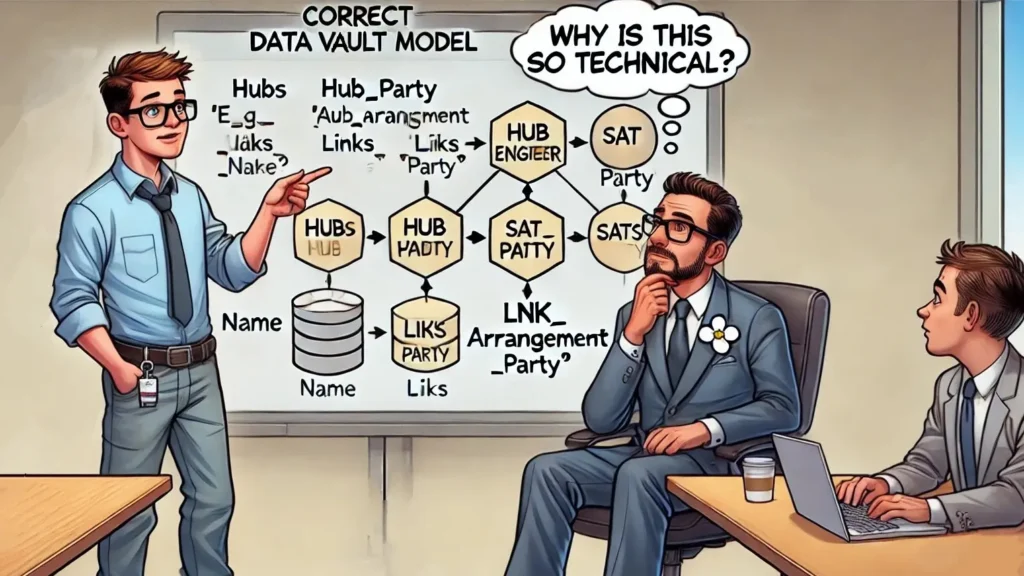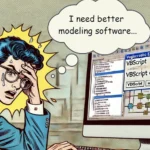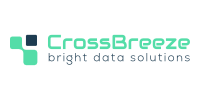Why Physical Modeling Isn’t Always the Best Choice
In many data projects, modeling is done only at the physical level, if at all. This means that the model you create is always specific to the technology you are using at that time. For example, a Data Vault for SQL Server is modeled or an Anchor model for PostgreSQL. See the image below for an illustration. The disadvantage of this is that these models need to be revised when you change technology or storage model. If you opt for logical modeling, you are not dependent on the technology you choose and it also better matches the experience of your stakeholders.

The right model at the right time
Each type of model has its own purpose and function within a data project. There are three important levels: conceptual, logical and physical. Conceptual describes the concepts in your data solution at a high level. In the logical model, the concepts are elaborated into entities with relationships and attributes. A physical model contains a translation of the logical model into a structure optimized for the chosen technology. By using the right type of model at the right time, you can improve communication and optimize the result.
Logical modeling helps stakeholders better understand
A big advantage of conceptual and logical modeling is that it is understandable for all parties involved, not just the techies. For example, when you present a certain model to stakeholders from the business, they should be able to recognize it: ‘Ah, this is about customers, leads, prospects and deals’ for example. If you are already using a model at this level with Data Vault concepts such as hubs, links and satellites, you will lose most stakeholders. They will not immediately recognize their business in the model and will therefore have less ability to validate whether you are on the right track. Logical modeling allows you to communicate in understandable terms, which also keeps people from the business involved.

A real-world example: product hierarchy modeling
Suppose you sell both physical products, such as a book, and digital products, such as software. Both have common characteristics, such as a price and a description, but there are also differences. For example, a physical product has a size and weight, while a digital product has a file size. In a logical model, you can capture this distinction well by using super- and subtypes, also called inheritance. In a physical model, this is often not possible. A physical model then already contains an implementation choice for these types of constructions, for example separate tables for physical and digital products where both tables contain the common characteristics. The product hierarchy that exists in practice can therefore be captured better in a logical model than in a physical model.
Logical modeling provides flexibility and efficiency
Logical modeling is not only more understandable for stakeholders, it also offers more flexibility in technological changes or insights. If an organization wants to change technology, what you want to achieve functionally remains the same. This means that the logical model for the new technology is the same as for your current one. In other words, you only need to derive a new technical model optimized for the new technology based on your logical model. Creating and maintaining a logical model therefore also prevents the original requirements from having to be discovered via the code or retrieved again with the stakeholders in these types of situations. At CrossBreeze, this is a starting point for our vision and many of the tools we develop. This also applies to our own data modeling tool, CrossModel. Modeling at a logical level makes your data structure sustainable and future-proof. This makes your projects more efficient and delivers more value in the long term.
Want to model more efficiently? We can help!
Do you want to get more out of your data models and work more efficiently? At CrossBreeze, we have years of experience with logical modeling and know how to optimize this process. Furthermore, we are specialists in using logical models for code generation. By working together with your stakeholders and building technology-independent models, we can make your data projects more successful. Contact us for a no-obligation conversation and discover what we can do for your organization.
We expect to have a beta version of CrossModel available for a select group of interested parties in early 2025. Do you want to stay informed of the developments and possibly be one of the first to test run CrossModel? Then register via this link.






